New perk! Get after it with local recommendations just for you. Discover nearby events, routes out your door, and hidden gems when you sign up for the Local Running Drop.
The Ups and Downs of Trail-Championship Racing
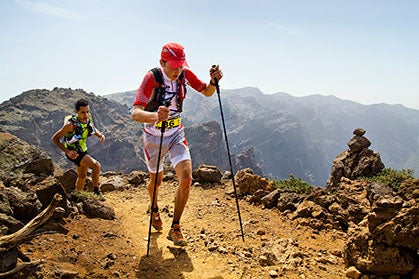
Fast-paced action in the Transvulcania Ultramarathon, Canary Islands, Spain, part of the competitive Skyrunner World Series.
Every year there seems to be a new race or series claiming to be the trail running championship. With that list growing over the past 10 years, there’s now a glut of events promoted by everyone from domestic to international governing bodies, from brands to individual race organizers. What’s a trail runner to make of it all?
Perhaps the takeaway is that we have a natural urge to compete and watch others do the same. It’s all the more exciting when the best of the best face off against one another in a championship. One of the beauties of our quaint sport is that back-of-the- packers toe the same line as top contenders, something you don’t see in many other sports.
Fortunately for us, the American trail-running calendar has championships from 5K to 100 miles. If there’s not enough variety among individual championship races to keep you interested, championship series have sprung up to crown the best contenders over a season.
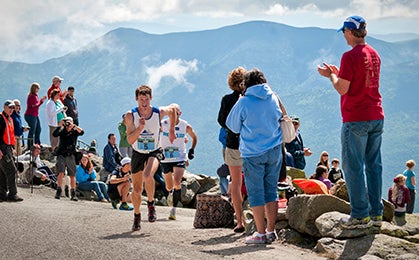
Max King pumping hard at New Hampshire’s Mount Washington Road Race. Photo by Joe Viger.
WHY HAVE CHAMPIONSHIP RACES?
Michael Wardian, a four-time USA and Field (USATF) national champion who may have run more championships than any other American, says, “I choose championship-style races based on the level of competition. If I can race the best, I will try to get myself to the starting line where I can push my limits.” Says Kami Semick, a world champion on the roads at 50K and 100K, “Personally, I can only peak for one or two key races a year. I am motivated by high-quality competition for those races.”
For Geoff Roes, the 2010 Western States Endurance Run (Western States 100) and 2010 Ultra Race of Champions victor, competition puts the accoutrements of a championship race in perspective. “In my mind, the depth of the field is the most important thing to legitimately view a race as a championship. Prize money, titles and other incentives are simply tools to increase the level of competition. It’s nice to win a championship title or some prize money, but all of this stuff, for me, is secondary to the experience of going out and racing with dozens of similarly capable runners.”
Dave Mackey, the 2011 USATF Trail 100K and Montrail Ultra Cup champion, admits, “If there is prize money, that can be equal to competition as a reason to attend.”
Ben Nephew, who has represented the United States internationally four times—twice at the International Association of Ultrarunners (IAU) Trail Championships and twice at the IAU 50K Championships—says there is nothing quite like competing for the U.S.A. in an international race.
Max King, who is no stranger to national and international championships with USATF trail national championships at the half marathon, marathon and 50K distances as well as a world mountain-running championship to his credit, says that championships also benefit trail running as a sport. “Competition and great athletes bring the sport into the public eye and progress it into a legitimate competitive sport.”
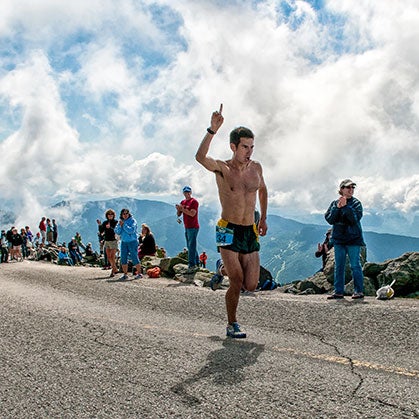
Sage Canaday takes the win, setting a new American record, at the Mount Washington Road Race, New Hampshire, the 2012 USATF Mountain Running Championships. Photo by Joe Viger.
USATF CHAMPIONSHIPS
Fans of American championship trail running can thank USATF, the national governing body for long-distance running, track and field and race walking. In 1998, USATF established the Mountain/Ultra/Trail (MUT) subcommittee to oversee these previously unrepresented disciplines.
In its initial meeting in December 1998, the subcommittee recognized the importance of championships. Its meeting minutes note, “We need to get the word out about our sport and it was agreed that championships would be a great way to do that.” With this in mind, the MUT leadership quickly established a national championship schedule with a 50-mile trail championship as well as 50K road, 50-mile road and 24- hour championships to be held in 1999.
But soon, the USATF recognized an institutional problem: the lack of bids for USATF championships events. After receiving 11 national championship bids in 2003 (eight of which were accepted), by December 2004, MUT had only received bids for 50K and 50-mile trail championships in 2005. The 2004 MUT meeting minutes recognize “[t]he bid form is a bit daunting.”
Subsequently, though, the USATF championship roster has steadily grown. For 2013, the MUT national championship roster stands at 12 races, including seven trail races. Still, MUT often receives only one bid for each championship.
In 2011, MUT added a point-based national-championship trail series, including 10K, 15K, half-marathon and marathon trail championships as well as the Mountain Running Championships, which were run on the trails of the Cranmore Hill Climb (see “Running for Red, White and Blue,” October 2011, Issue 75). The series continues in 2013, and the most competitive races should be the Mountain Running Championships at the Cranmore Hill Climb in New Hampshire and the marathon championships at the Pikes Peak Marathon in Colorado, which has drawn top runners from around the world for decades.
Despite being the longest-held, trail-running championships in the country, the USATF events have not recruited super-deep fields. This may be due to any number of reasons. Perhaps rifts between the USATF and top athletes early in MUT’s existence and a continued uneasy relationship due to inadequate funding of U.S. competitors at international championships have set the organization back.
Whether due to onerous bidding or unwanted event conditions, there continues to be a disjunction between our sport’s most competitive events and those that serve as USATF championships. Maybe at 12 races with open and masters and age-group national champions, the USATF MUT championships have diluted themselves out of relevance.

Tony Krupicka and Geoff Roes in the hard-fought 2010 Western States 100-miler, now the crowning race of the Montrail Ultra Cup series. Photo by Luis Escobar.
MONTRAIL ULTRA CUP
A dozen years ago, looking for a way to determine the best ultrarunners and broaden interest in the sport of ultrarunning, Scott Tucker, then president of Montrail, and Greg Soderlund, then race director of the Western States 100, came up with the idea of the Montrail Ultra Cup, which was brought to life by then Montrail employee Krissy Moehl.
Inherently, a single championship race determines only who’s the best at a particular distance on a given day. The inaugural Ultra Cup attempted to crown a broader champion by requiring participants to run one race each at 50K, 50 miles and 100 miles as well as a total of four races out of the six well- established ultras in the series: Way Too Cool 50K, Promise Land 50K, Western States 100-Mile, White River 50-Mile, Wasatch Front 100-Mile and Mountain Masochist 50-Mile.
In 2002, Scott Jurek and Luanne Park were the inaugural series champions, taking home $5000 each. Montrail also recognized champions at each distance. Moehl, now a Patagonia ambassador, notes, “The athletes liked the idea of earning a bit of cash, but [even the winners] couldn’t net any money with all the travel.”
Over the past decade, the Montrail Ultra Cup’s format has undergone near-constant adjustments. Throughout those changes, the series has consistently resulted in victories by well-known ultrarunners, such as Meghan Arbogast, Nikki Kimball, Dave Mackey and Timothy Olson. Moehl says, “The sport will always have grassroots, but the Ultra Cup made ultrarunning a sport.”
The Ultra Cup now starts each summer and wraps up with the Western States 100 the following June. This season, runners accrue points from their best race at each of the Cup’s four distances: 50K, 50 miles, 100K and 100 miles. Points are weighted based on the length of the race and podium finishes, putting a premium on winning the two 100-milers, Pinhoti and Western States.
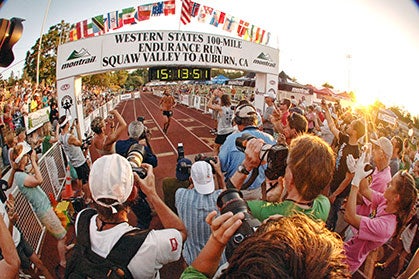
Krupicka crosses the 2010 finish line in course-record time, but second to Roes. Photo by Luis Escobar.
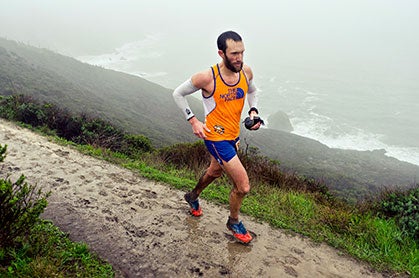
Mike Wolfe battles tough conditions at the 2012 TNF Endurance Challenge 50-Mile Championships, San Francisco, California. Photo by Matt Trappe.
THE NORTH FACE ENDURANCE CHALLENGE
It took five years after Montrail founded the Ultra Cup for another trail-running company to support a new trail-running championship event. In 2007, The North Face (TNF) established its Endurance Challenge series with regional events followed by a series championship run in the Bay Area’s Marin Headlands. According to Katie Ramage, Director of Sports Marketing at TNF, “The goal of the Endurance Challenge Championships was and is to create a high- stakes, high-quality series … that draws runners from around the world and provides yet another opportunity for the elite community to come out in full force.” An unheard of $20,000 in prize money split between the men’s and women’s winners helped spur the likes of Matt Carpenter, Uli Steidl, Lizzy Hawker and Jenn Shelton to the inaugural TNF championships presented by GORE-TEX.
Now, with a $30,000 prize purse, the second-largest in American ultrarunning, the TNF Endurance Challenge 50-Mile Championships continue to bring the very best out to the Bay Area every December. In 2012, the TNF 50-Mile Championships (TNF 50) were one of the most competitive non-100-mile trail ultras in the U.S. and, possibly, the world. Headlining the men’s field were Miguel Heras, Mike Wolfe, Sage Canaday, François D’Haene, Adam Campbell, Dave Mackey and many more. The women’s field was no less exciting, with Emelie Forsberg, Lizzy Hawker, Krissy Moehl, Kami Semick, Caitlin Smith, Brandy Erholtz, Megan Kimmel and Joelle Vaught among the starters.
While the 50-mile championships are the marquis event, each of the six TNF Endurance Challenge locations features at least half a dozen races ranging from a one-kilometer kids’ race to ultra- distance events. This format undoubtedly motivates new and veteran runners alike.
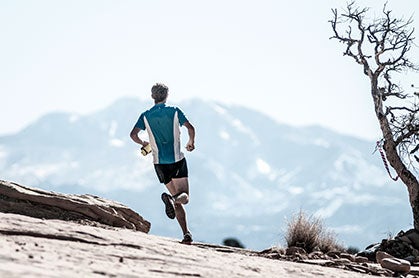
Action at mid-February’s Moab’s Red Hot 33K, Moab, Utah, the first race in this year’s La Sportivia Mountain Cup. Photo by Chris Hunter.
LA SPORTIVIA MOUNTAIN CUP
The rise of ultramarathon championship races and series was contrasted by the seeming lack of marathon-and-under trail championships on the national stage. Since the mid- 1990s, Federation for Sport at Altitude and, later, the International Skyrunning Federation (ISF) governed championships- style races and series in Europe and around the globe. Informed by that scene, Buzz Burrell, then La Sportiva’s Running Coordinator and current brand manager for Ultimate Direction, “wanted to bring fast-and-exciting European mountain running to the U.S.” The result was La Sportiva launching its eponymous Mountain Cup in 2008.
The race lineup changes from year to year; however, Park City, Utah’s Jupiter Peak Steeplechase has become a staple, serving as the series’ finale for the third straight year in 2013. Currently, the series is scored by adding up a racer’s four best performances out of the series’ 10 races with more bonus points available the better the competition. As a result, there’s gamesmanship involved as to which series contenders will show up to which races, and the series is often a battle to the end between racers who’ve grown to know each other well.
Many-time Mountain Cup competitor Jason Bryant says, “Mountain Cup competitors are an extension of the trail community that is connected, supportive and friendly. We go at it on the course, but grab drinks and meals as friends post race.”
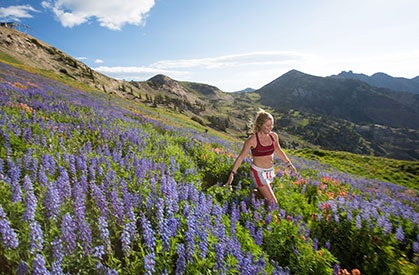
Anna Frost in a relaxed moment at the brutal 2012 Speedgoat 50K, Snowbird, Utah, an Ultra SkyMarathon Series race. Photo by Kevin Winzeler.
SKYRUNNER WORLD SERIES
While the Skyrunner World Series (SWS), organized by the ISF, is entering its 10th year, both the series and organization are just starting to attract the attention in the U.S. that they’ve long received in Europe. Last year’s outreach by the ISF to top American trail runners with invitations to the Transvulcania Ultramarathon, Zegama Marathon and Cavalls del Vent did much to spark this. Says ISF Executive Director Lauri van Houten, “For American runners it represents a new challenge in many ways—more technical, steep courses, the supporters, the fans and the atmosphere.” (see Adventure, April 2013, Issue 87)
The SWS has continually evolved, with 2013 seeing a new format, three five- race circuits each focused on a separate Skyrunning discipline: the Sky Series (races from a half-marathon to just over a marathon), the Ultra Series (races 50K to 170K) and the Vertical Series (vertical kilometer races). As it was last year, the Pikes Peak Marathon is part of the Sky circuit, while the Speedgoat 50K returns to the Ultra circuit. As noted above, UROC will be the finale of Skyrunning’s 2013 Ultra Series and, as such, figures to gain a significant contingent of top European competitors if last year’s Speedgoat 50K is any indication (see “Speedgoat 50K Has Decadence and Decree,” October 2012, Issue 83). Last year was Skyrunning’s first foray into an ultra series. Van Houten explains, “It’s a natural evolution—people are continually looking for greater challenges, higher, faster, longer.”
Americans look to further embrace Skyrunning in 2013, with Anton Krupicka, Rickey Gates, Stevie Kremer, Cameron Clayton, Alex Nichols and Luke Nelson all signed up for at least three races, the minimum number of races to gain series ranking.
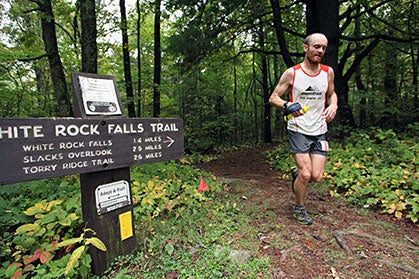
Geoff Roes en route to victory at the inaugural Ultra Race of Champions, Virginia. Photo by Joel Wolpert.
ULTRA RACE OF CHAMPIONS
Along with Dr. Francesca Conte, J. Russell Gill founded the Ultra Race of Champions 100K (UROC) in 2011 “to determine the best ultra-distance athlete by creating a single-day championship, with a course and distance that levels the playing field, with incentives to encourage the world’s best ultrarunners to participate.” In 2011 (see “Ready or Not,” December 2011, Issue 76), those incentives included $10,000 in prize money, which was upped to $20,000 in 2012. The race also put together an Elite Advisory Committee composed of top ultrarunners to help recruit others of their ilk. They succeeded. The first year’s race featured Geoff Roes, Dave Mackey, Michael Wardian, Ian Sharman, Devon Yanko (formerly Crosby-Helms) and Anne Riddle Lundblad, while 2012 saw an even stronger field featuring Max King, Sage Canaday and Ellie Greenwood.
Roes, who heads UROC’s Elite Advisory Panel notes, “I think UROC is a really important step in the process of championships in ultrarunning. It’s basically the only event in the sport right now that is specifically focused on taking measures, such as reaching out to top runners, providing travel and lodging assistance to some, as well as paying appearance fees to a limited few, to draw as deep and fast of a field of runners as possible.” In 2013, UROC will be sure to see even more top runners than ever as it’s moved to the Colorado Rockies and will host the 2013 Ultra SkyMarathon Series championship.
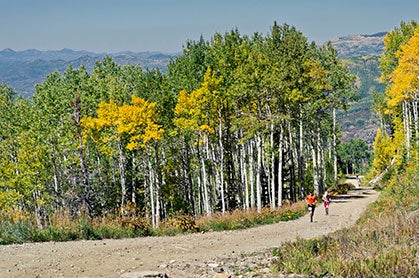
Runners vie for chunk of the $40,000 prize purse at the Run Rabbit 100, Steamboat Springs, Colorado. Photo by Matt Trappe.
UNOFFICIAL CHAMPIONSHIPS
With so many events hoisting the championship banner, they must still compete with what many consider several “unofficial” championships. Wardian, who’s won his share of official championships, says, “There are some races that draw the best runners in the world and are not recognized championships.” Despite winning USATF trail national championships at 50K and 50 miles, Semick agrees, “The USATF- and [IAU]-sanctioned races do not necessarily attract the ‘best’ runners from around the world. I do think there are de facto championships such as Western States, the TNF 50 and The North Face Ultra-Trail du Mont-Blanc [UTMB].”
Roes is drawn to competition regardless of whether a race is an official championship. He notes, “It just so happens that currently many of the more competitive ultras in the world are unofficial championships. I think this speaks to the lack of focus and intent on the part of many of the existing official championship races.”
For some examples of unofficial championships, let’s take a look at 100-mile races.
While a few top runners will toe the line at Ohio’s Burning River 100 mile in July for the USATF Trail 100-mile championship, it’s unlikely to be even one of the top five most competitive fields of American runners in a 100-mile race this year.
For most of the past three decades, the Western States 100 in California has been the de facto 100-mile world championship. It’s been a long time since Western States offered prize money and it’s never been the USATF championship. However, as the oldest, most prestigious and, until recently, unquestionably the most competitive 100-miler in the world, Western States boasts its status without the race having to say a word.
Despite Western States’ history and continued competitiveness, another race is poised to challenge for the mantle as 100-mile world championship. In 2012, the field for UTMB was as strong as that at its Californian predecessor despite being only 10 years old and also refraining from offering prize money. In fact, with more top Americans showing up at UTMB than top Europeans at Western States some years, such as in 2011 and possibly again this year, the Alpine adventure is certainly in the running as the new de facto 100-mile world championship.
Age, size and prestige are not enough to guarantee another race won’t attempt to reach championship status. New in 2012, the Run Rabbit Run 100 in Steamboat Springs, Colorado, aims to unify top 100-mile talent that is spreading itself between Western States, Hardrock, Leadville, UTMB and other 100-mile races. To this end, the race offered trail ultrarunning’s biggest ever prize purse—$40,000—in 2012 with an eventual goal of offering up to $100,000.
Shorter trail races follow in the same vein. For example, for many years, the Pikes Peak Ascent and Marathon have attracted championship-caliber fields even in the majority years in which neither race has an American or International championship designation.
LOOKING AHEAD
Pondering the future course of trail-running championships in America is akin to staring out at an endless expanse of slickrock. New championships can come from anywhere at any time, challenging the dominion of existing races. As we move forward, will the range of championship offerings become ever broader or will the various methods of drawing together championship fields—prestige, history, official designations, prize money and course desirability, to name a few—merge sufficiently to offer a discrete set of championships that everyone can agree upon?
Bryon Powell is Runner-in-Chief at irunfar.com.